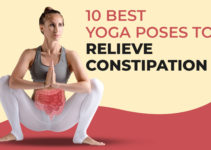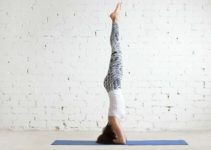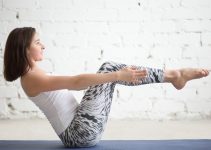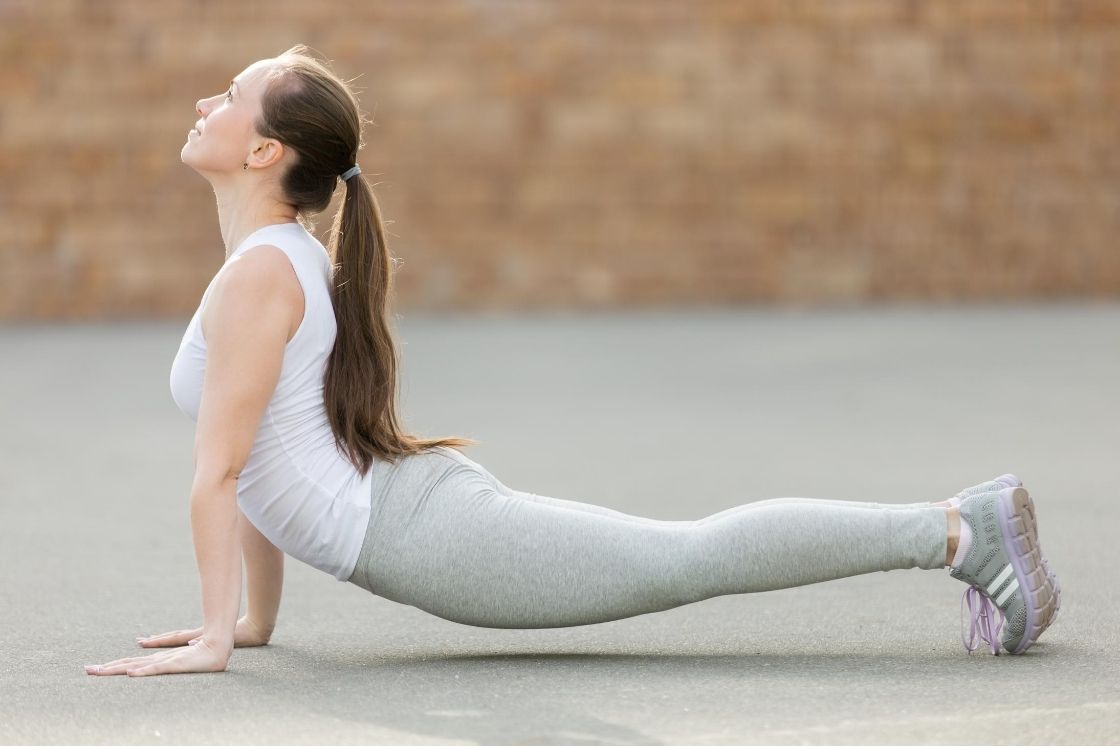
Upward facing dog is one of the popular poses you must already have practiced in some vinyasa flow. On doing this pose you will feel the vitality of your arms and a rejuvenating current will start flowing from your core muscles to the front chest.
In the yoga poses classification, it comes under the back-bending series poses which has a Prone position from the beginning. Holding the body in this position awaken the strength in the upper body; by stimulating musculoskeletal regions.
Urdhva Mukha Svanasana – Meaning And Interpretation
Nature and the activities of its creature have always been a part of Yoga. Many asanas of yoga are derived after observing common activities of living beings and one of them is the upward facing dog pose.
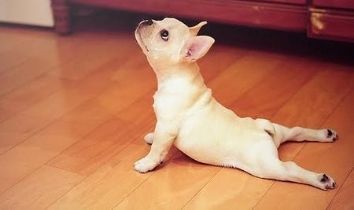
In Sanskrit, it’s called Urdhva Mukha Svanasana. Urdhva having translation ‘Upward’, Mukha means ‘Face’, Svaan is called to Dog in Sanskrit and asana means pose. Usually, a dog is seen in this pose shows the humbleness, loyalty, and love of dogs to their owner. Though, physically this stretching extremely benefits for dogs to alleviate their pain and musculoskeletal problems.
Upward facing dog pose in yoga is normally called by teachers to its short name “upward dog” or “up dog”. Generally, it’s practiced as part of beginning Vinyasa flow to warm up the forearms muscles, thighs muscles, and open up the chest.
In the 20th century, T. Krishnamacharya has introduced an Upward Facing dog along with its sibling pose Downward facing dog from Surya Nmamaskara; when it was not considered as yoga.
Upward Dog vs Cobra
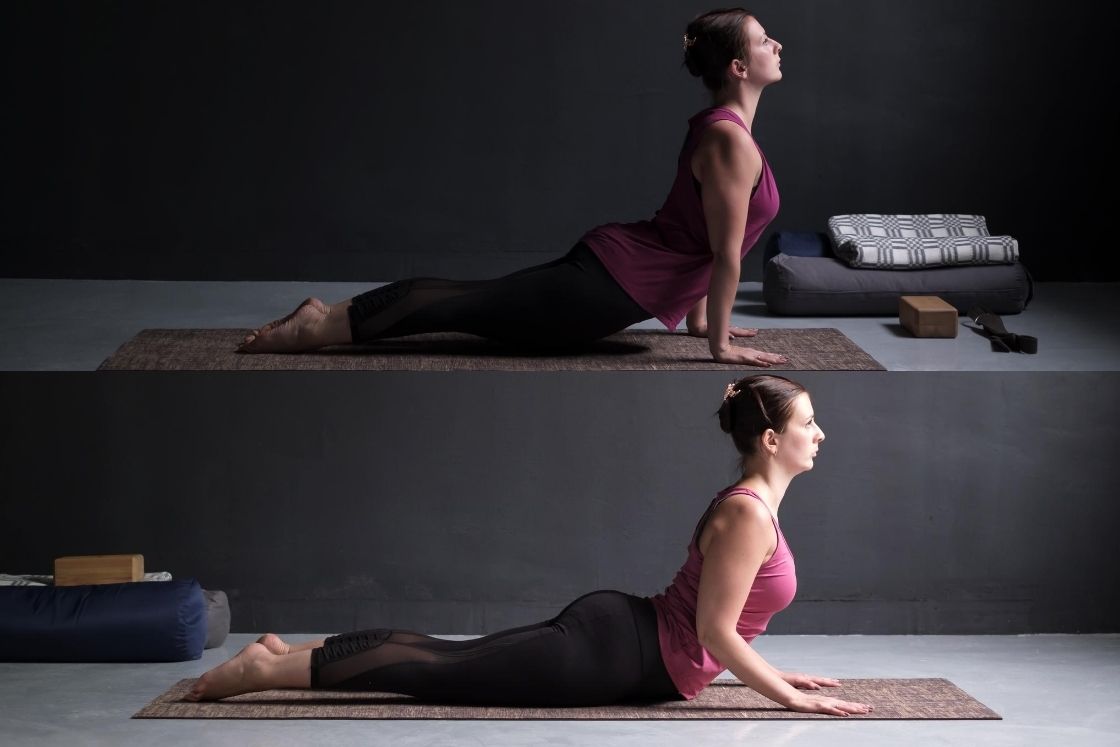
However Upward dog looks similar to a famous cobra pose of Sun Salutation series, but several key points distinct them from each other.
- The first difference can easily be noticed just by the physical appearance of the body in both poses.
- In Upward facing pose, hands and wrist on the floor come directly under the shoulder line while in cobra pose hands are placed a bit forward to the shoulder’s level.
- Upward dog and cobra are both practiced in prone position i.e. lying on the stomach but pelvis and legs are slightly off the floor in Upward dog while in cobra pose it remains on the floor.
Upward Facing Dog Practice Guide
This asana can be well practiced by going through the given steps.
Contraindications
- Pregnant women avoid doing upward dog pose as it stretches abdomen which could have a constricting effect.
- Practitioners with the condition of carpal tunnel syndrome (numbness, tingling, or weakness in the hand) should ask an expert to guide in up dog pose.
- Do not practice if there is an injury to the shoulder, wrist, back, or in the abdomen in the recent past.
Preparatory Pose
- Bridge Pose (Setu Bandha Sarvangasana)
- Four-Limbed Staff pose (Chaturanga Dandasana)
- Cobra pose (Bhujangasana)
How to Do Upward Facing Dog (Steps)
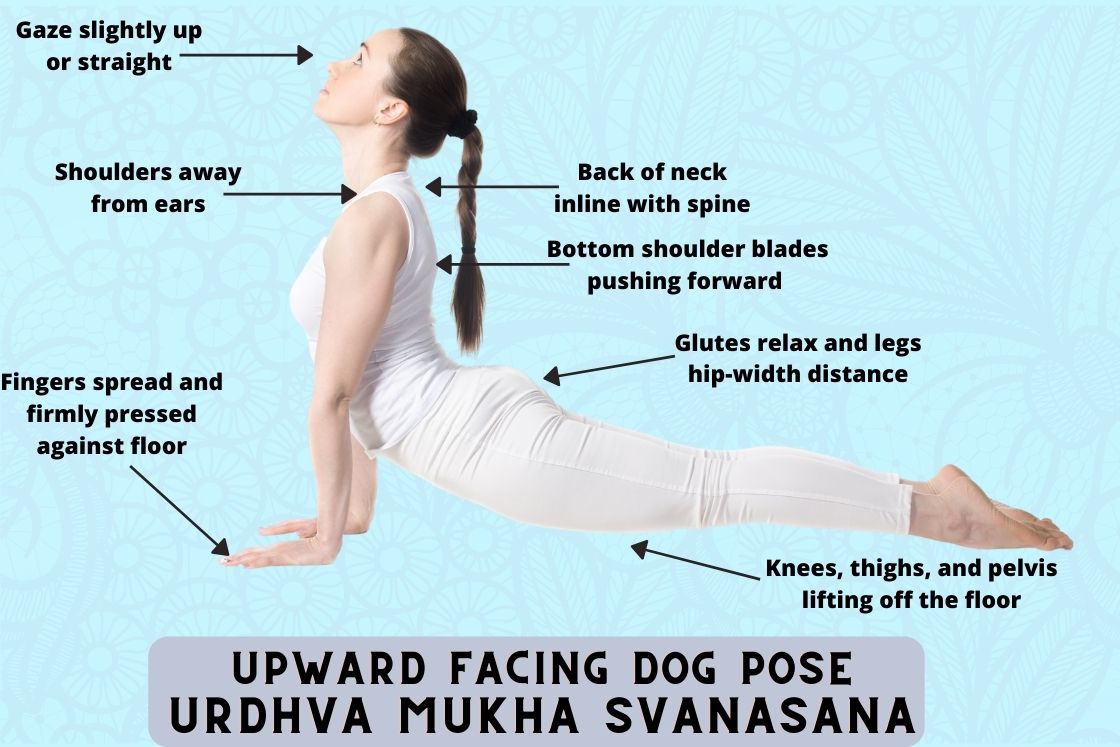
- Lay down on your mat in the prone position i.e. stomach touching the mat, legs straight and hip width-distance, hand beside the hips and feet flat on the floor in a relaxing manner.
- Now, bend your elbow and place them near to your lower ribs or slightly upward from your waist; here your forearms become perpendicular to the floor.
- After that, spread your fingers, press palm firmly against the floor and thighs inwardly rotate. Here, Inhale and roll back your shoulders so that bottom of shoulder blades moving forward to open the chest.
- Now with further inhalation, straighten your arms and lift your torso while pressing the feet; raise chest, then pelvic, then thighs off the floor so finally your body weight will be on your palms and feet. Here, the front of your feet should be pressed against the floor to engage the legs and thighs muscles.
- It’s the final position of the upward facing dog, our arms will be straight, shoulder remains away from the ears, head lifted and slightly tilted backward and gaze straight.
Maintain the posture for several breaths or at least 1 minute, though one can go for a longer duration when comfortable. - Afterward, return back to the prone position by lowering the body and relax.
Beginners Tips
- Commonly beginners either flare out elbows from the sides or squeeze the sides in the Upward dog. Maintain elbows in between these two positions to properly lengthen the spine in the final position.
- Avoid hanging of the shoulders in which ears come closer to them. Beginners should engage their side ribs front and shoulder blades to the tail bone.
- Beginners sometimes end up in dropping their thighs which makes a pose saggy; Therefore, one should engage their thighs to make pose dynamic and approaching.
Props and Modifications
- Use Yoga block underneath your hand to provide more space to the body; which further ensures appropriate lifting.
- In case of sagging or dropping thighs one can use a rolled blanket under their thigh; which adds on the engagement of leg and makes posture more active than before.
Variations
1. Eka Hasta Urdhva Mukha Svanasana – One-Handed Upward-Facing Dog Pose
As name shows, in this advance variation of upward dog the body is lifted on one hand instead of both hands.
- Begin from the accomplished position of upward dog; By shifting your body weight on the flat feet and left hand.
- slowly raise your right hand back while tilting the head back as well and look slightly up.
- Maintain the pose as per the comfort and repeat the asana with another hand as well in a similar manner.
2. Eka Pada Urdhva Mukha Svanasana (One-Legged Upward-Facing Dog Pose)
In this variation, in contrast to raising one hand up, one leg is lifted after accomplishing base upward dog pose.
- Transform into this variation from the base asana by shifting the body weight on two hands and left foot.
- Slowly lift your leg and bent it in a manner that big toes pointing the back of the head; While your chest and head remain straight.
- Remain in the asana as long as possible and then perform the same sequence with another leg.
Upward Facing Dog Benefits
- Stretches and Strengthens arm, wrist, spine, and shoulder – In Upward dog, most of the weight-bearing is done by the set of the wrist, arms, spine, and shoulder; this stretches and strengthens the concerning body parts.
- Improve Digestion – Backward bending in Urdhva Mukha Svanasana has a massaging effect over the digestive organs; that stimulates their function pretty well; which results in better digestion and assimilation.
- Therapeutic in Respiratory Disorders – This asana helps in broadening of the torso that supports the stress less breathing; which ultimately eradicated or reduces pulmonary disorders. Moreover, it also prepares a practitioner for Pranayama practice.
- Reduces Mild depression, Stress, and Anxiety – Practicing Urdhva Mukha Svanasana loosen up the muscles and increase the blood circulation that produces a soothing effect on concerning region; this further tranquilizes the mind.
- Develops Strength and Balance in Adolescents – Regular practice of this in puberty works as an eminent tool in carving the health of practitioners; It makes bones strong and develops a sense of balance between the mind and body.
- Stimulate abdominal Organs – The second variation of this asana stretches abdomen intensely, which results in the stimulation of abdominal organs; Moreover, it also restores their functioning.
- Reduces Postural Deformities – Stretching of back regularly by the practice of this asana correct the spinal disfigurement; like kyphosis, Lordosis and Scoliosis. Hence, it corrects at some level or reduces the bad posture.
